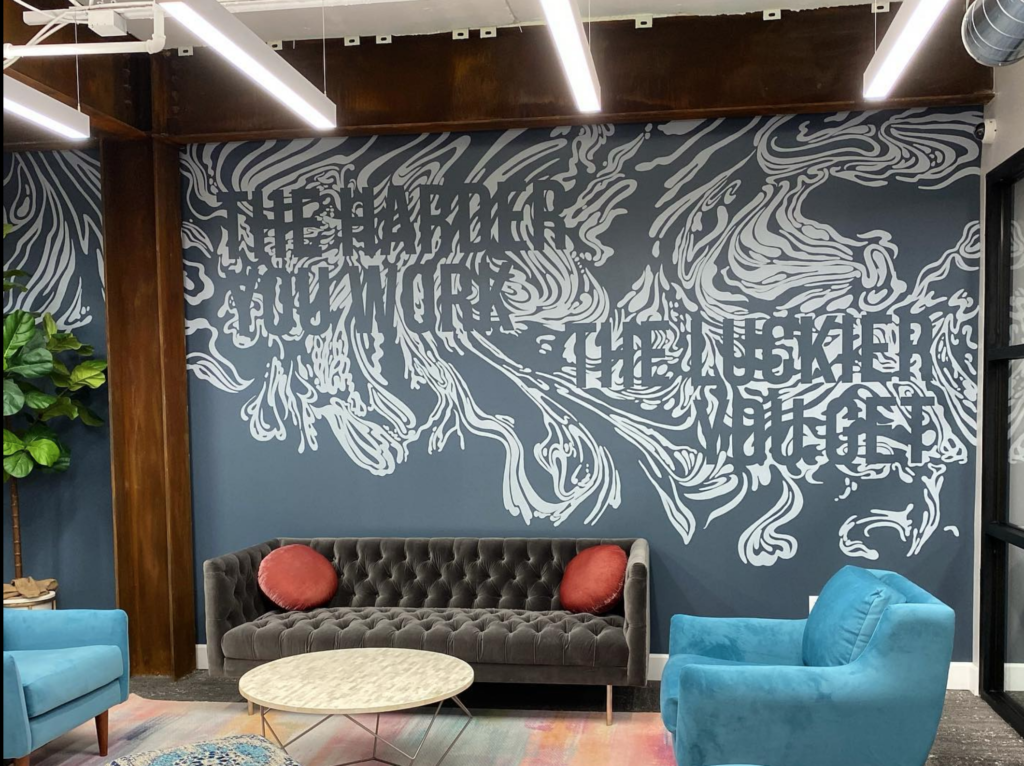
You only have to spend a bit of time in Tucson to learn one thing: we love our art and we love our murals. The city is full of beautiful, colorful, and creative pieces of artwork on the sides of buildings or in private businesses.
Ashley White and Shaurir Anand are the masterminds behind some of the amazing pieces you’ll see throughout the city. In fact, Ashley created one of our own amazing murals right here at The Post!
Their company, Delsa Designs, offers full-suite creative services to local businesses, using artwork to attract customers and create a positive and memorable environment.
They recently sat down with us to discuss their own process and inspiration plus the power of art on both local businesses and the impact it has in Tucson. Here’s their story.
The Post: Can you tell us a bit about your background and what you do?
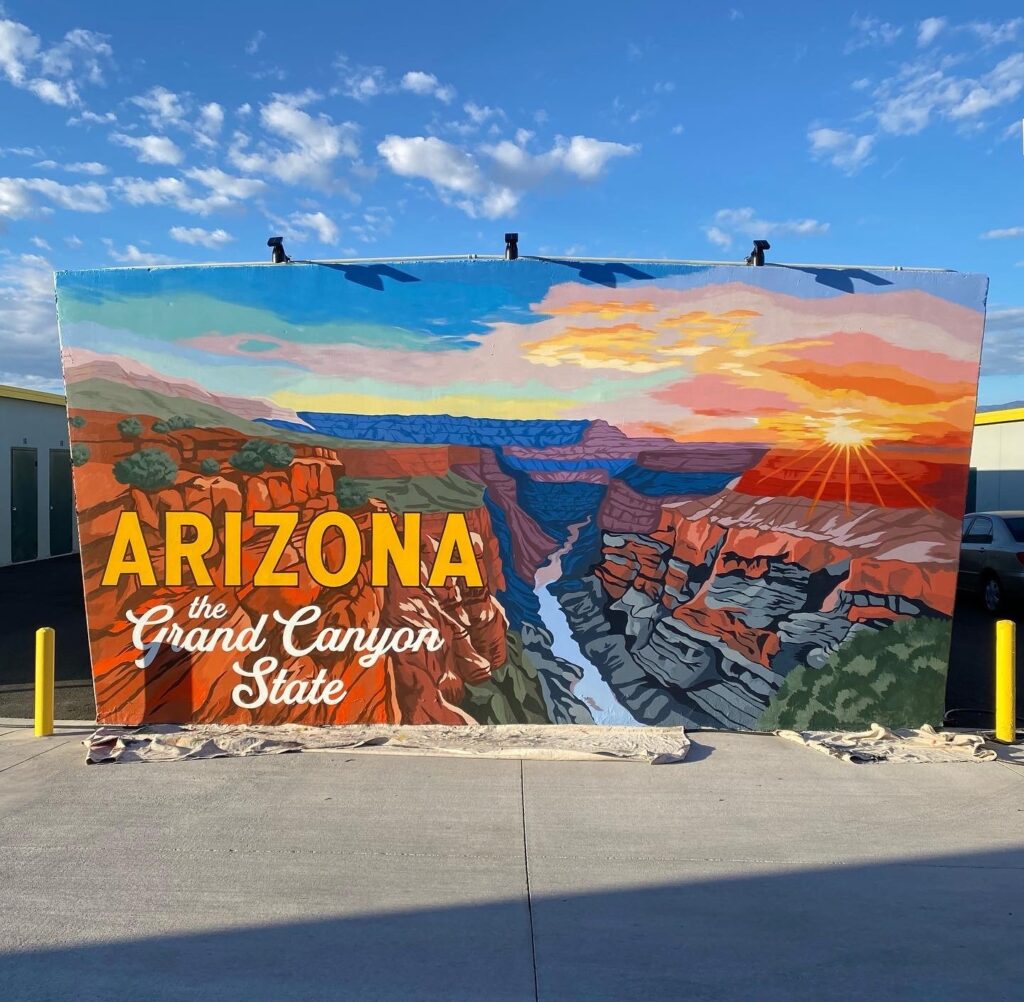
Ashley White: I’m a commercial artist, creating work for clients like restaurants, bars, cafes, hotels, and Airbnbs. I started this work in 2013, pivoting towards art after graduating college in a different field and feeling very unfulfilled there.
I initially started with chalkboard menus at restaurants and grew into sign paintings and murals. I love the intellectual aspect of creating artwork for a specific purpose, integrating it with the business’ brand and context. At first, I wasn’t sure exactly how things would play out—even though I always loved drawing and painting, I never thought of a career path besides becoming a fine artist or gallery artist.
Shaurir and I have been working together for the last three years, and since we partnered, we have expanded our business to branding and interior design. We’re a full-service commercial art business, where we do everything visual from concept to digital branding to interior artwork or exterior murals.
Shaurir Anand: Similarly, I was in a role that wasn’t completely fulfilling. I spent over a decade as an intellectual property lawyer. It was good in some ways, but since I have that creative bend, I was not getting enough satisfaction. I had even picked intellectual property law because I figured I would work with creative people. Eventually, I wanted to dive all in and Ashley was kind enough to partner with me and we built this business.
What does your collaboration process with a client look like?
Ashley White: In the beginning of my work as a commercial artist, I would reach out to businesses and just say, “Hey do you need any artwork?” Everyone is very friendly in Tucson and I got a lot of jobs early on through outreach like this. They saw my talent and I did all kinds of things—chalkboard signs, creating designs for cocktails, or whatever they needed.
Over the last few years, I’ve built a reputation in Tucson and a recognizable portfolio of work. Some have even told me that we knew we wanted your artwork before designing the menu. I’m so grateful for that!
Sometimes, clients know they want to work with me and know they need some kind of signage but aren’t 100% sure what they need. I love that I get to come in and make recommendations for murals and/or signage that really works for their space.
What role does art play in a business identity and brand?
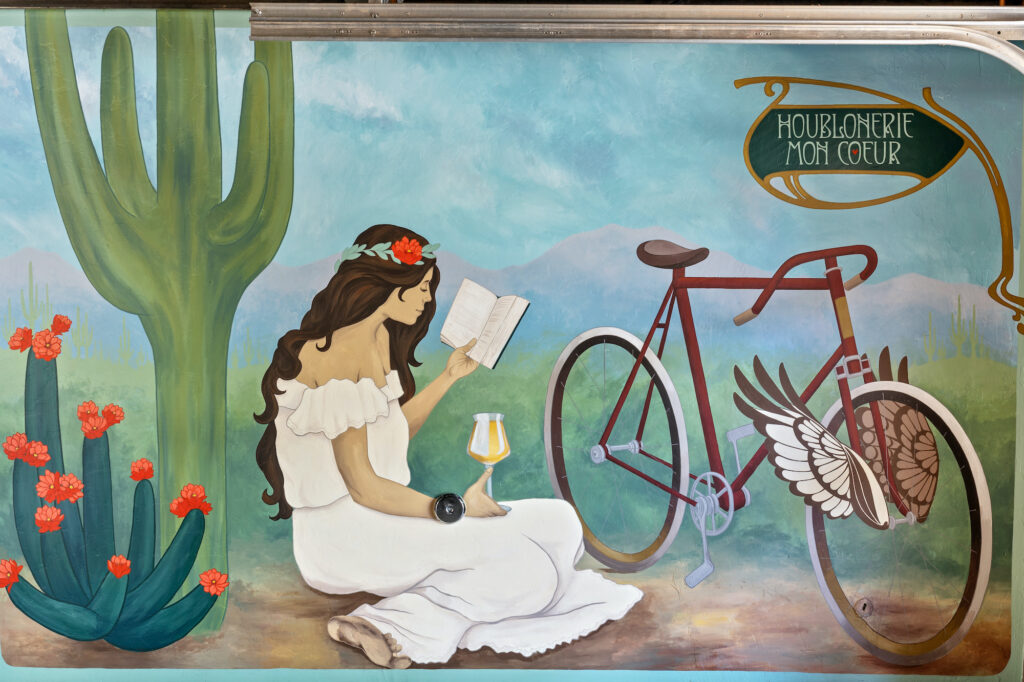
Ashley White: I think that art has an impact on multiple levels. Some of it is overt—when a client comes in and says, “Oh that’s a cool mural,” it’s an obvious positive impact.
But there are more subtle, subconscious impacts, too. We are always trying to create a branded environment that’s a full experience. It’s more than slapping up an 8X10 mural on a wall that could go anywhere—it’s about creating a place that is memorable and has an identity.
One example is my work with the Tucson Hop Shop, one of my earliest clients. At that time, their branding referenced 1960s Grateful Dead posters and was influenced by the Art Nouveau style.
When they first hired me, I created a sign and mural influenced by those same things. But then it kind of came to this idea: what if Art Nouveau originated in the southwest instead of Europe?
So we designed murals of desert plants in the Art Nouveau style, celebrating what’s unique about Tucson and the elements Tucsonans love about this place. One of the murals features a woman and her bike, taking a break, and reading a book with a beer. A lot of customers at Tucson Hop Shop come on their bikes because they’re close to the bike path, so the image resonated with their clientele.
So, it’s about creating an environment that fits into that business and who their customers are. It doesn’t have to be in an overt way but creates the overall environment.
How does artwork tie into Tucson’s overall culture? And, more specifically, how does it impact the city’s business district?
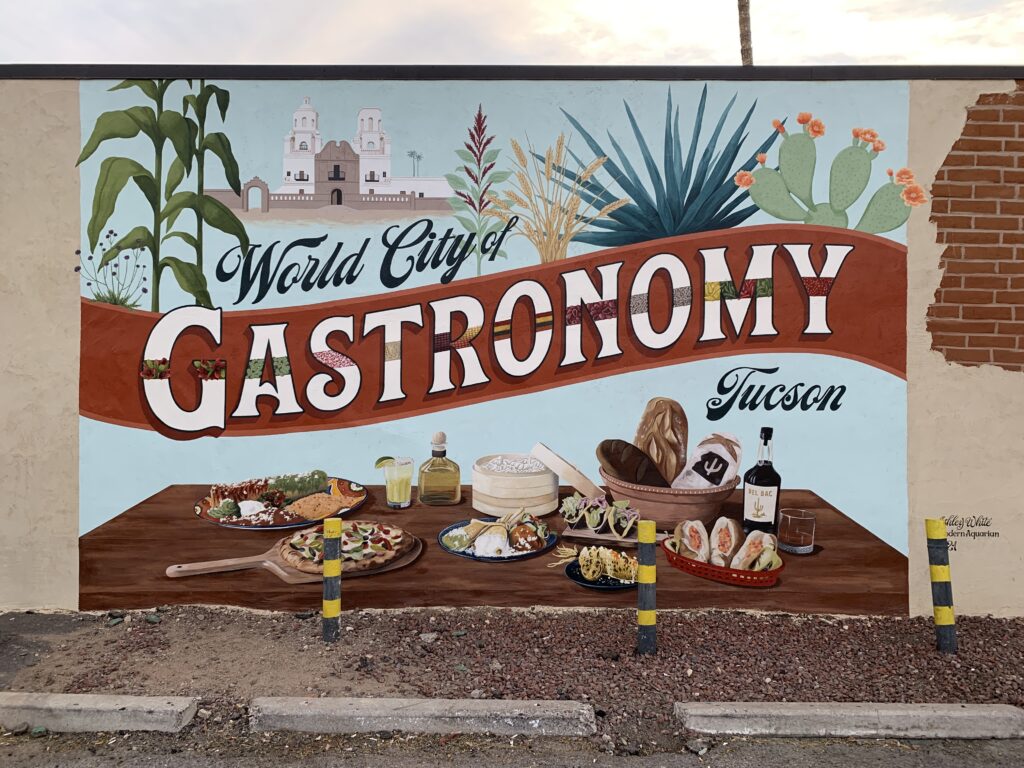
Ashley White: When you think about interesting cities to visit—say New York, San Diego, Portland, Seattle, Austin, San Francisco—there’s a commonality: they all have a lot of artwork and murals everywhere. Their restaurants are uniquely designed, the branding is funky, and it’s memorable.
People connect with it and want to share their experiences with other people. They might visit a really cool brewery with an interesting mural and want to share that with their friends.
Artwork totally changes the experience you have in a place. It attracts people and makes them connect with the business. The right kind of artwork shows the care of the business owner to put effort into the space. Even more corporate businesses like larger corporations or apartment buildings can benefit.
When people come to visit Tucson, it’s really common to walk around and see all the murals in the city. It creates a sense of pride in where we live.
A business’ artwork not only attracts customers and helps with publicity when people take pictures and share them online, but they can also repurpose it to create merchandise to sell. At Tucson Hop Shop, again, we took a mural and turned it into posters, and then other murals and put them on beer glasses.
We also did the artwork for a bar called Snake and Barrel, and created a series of three snakes paired with a different spirit—it was repurposed to sell as prints and postcards. They’re a speakeasy, so we didn’t want a big sign at the door, but we just made a cool monogram with the “S” and “B” so people knew something was there, but you didn’t exactly know what it was. They turned that monogram into coasters and glasses to sell and they were really popular.
Shaurir Anand: Sometimes people just come up and say, “We want something that’s Instagrammable. We want something that somebody’s going to take pictures with.” We try to come up with a design that works for them and will attract those selfies and photos.
Can you tell us about the mural you did at The Post?
Ashley White: The Post specifically wanted to use the quote, “The harder you work, the luckier you get,” and also provided us with some photos for inspiration. We always want to create something unique, so we reinterpreted those things and created something to match the vibe that they were going for.
We wanted to create something that would appeal to anyone who would be working there and also wouldn’t be boring over time. Ideally, people could come back in even after a couple of years and still find interesting elements there.
What advice would you give people who want to pursue their passions and might be afraid to dive in?
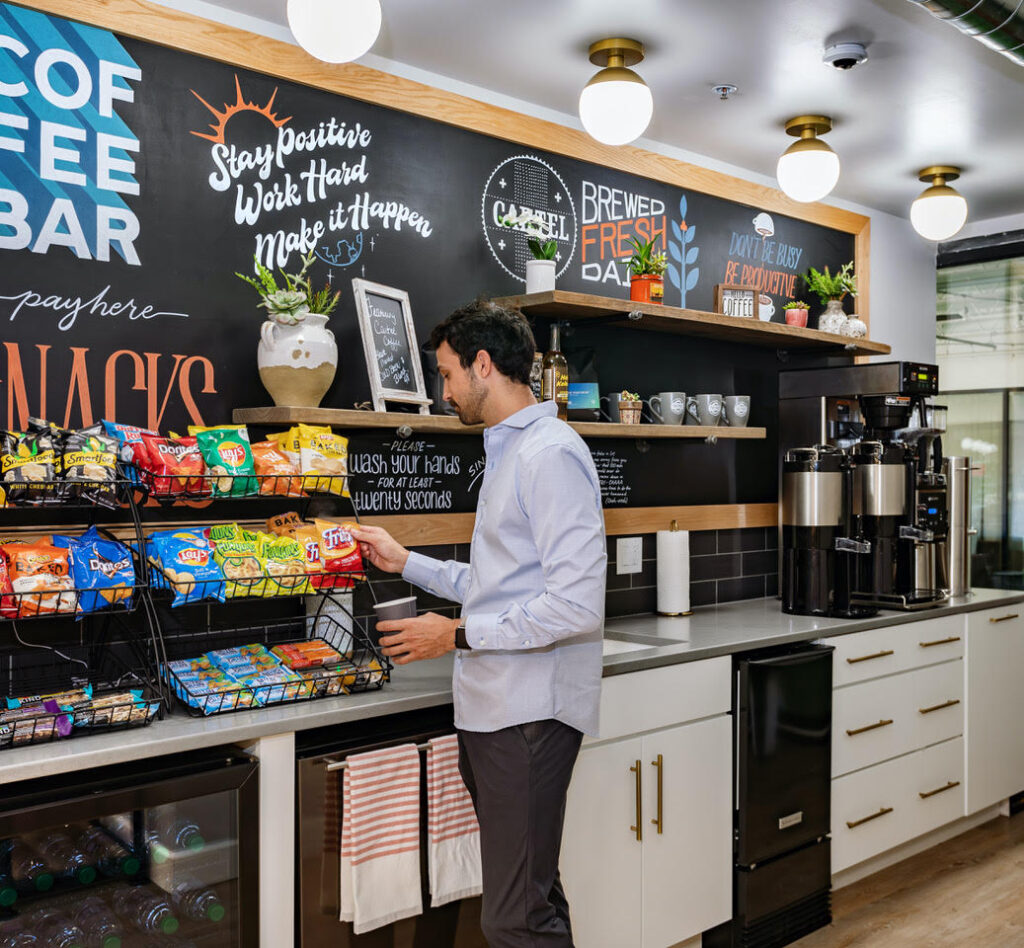
Ashley White: My biggest advice is that you have to be willing to get creative with how you generate an income. If I just stuck with painting murals, I wouldn’t have the growth I have experienced. I started by casting a wide net to see what I liked, what people responded to, what was viable, and what was profitable. From there, I’ve been able to narrow things down. But initially, people didn’t know my artwork, so I had to reach out and try a lot of things to build a portfolio and a name for myself.
The second piece of advice is to understand the business side of things. As much as you love dance or music or writing or artwork—whatever you’re talented at—you have that it is a business and that it has to be profitable. To be able to do what you want to, you have to do what you have to in a business scenario.
If you don’t focus on the business side of things, you won’t make it. Even if you get some traction and something blows up or goes viral, at some point you have to make it sustainable.
We were very lucky during the pandemic to keep getting work. We had our portfolio and reputation and business in place so people still wanted to work with us. But it showed us how unpredictable the economy is and how understanding the business aspect of things is so important for your security and sustainability.
Shaurir Anand: Ashley’s been doing this for over a decade, but there are still a lot of projects we take on where we’re learning new things. Not just in terms of painting techniques and what kind of brushes to use, but also safety and how to approach the project. The highest mural we’ve done is 25 feet, but we’re getting ready to do a 60-foot one. So, we’re getting training to ensure we know how to operate things and stay safe.
In terms of advice, I would also add that you need to be ready to pivot.
We were fortunate that, during the pandemic, an old client we had done menu boards for reached out and asked if we could do an entire rebranding exercise, including logo, murals, packaging, and interior design.
We took that opportunity on, and it resulted in us being able to expand our services into something new and exciting.
Now we find ourselves in a place where we are consistently working on all the different services we offer. On the same day, you may find us painting a mural in the morning, showing tile samples to a client in the afternoon, and creating a logo in our studio that evening. This has been a blessing and it has been so gratifying.
The other part of the business side is understanding that not every job is going to be a cakewalk—you’ll have difficult clients.
By difficult I mean some clients have a clear vision, and some don’t, and that’s okay. You have to be able to navigate that and do that dance with them. Understand that they have come to you because they trust your skills and talents, and have conversations with them to figure out how what you do translates to their vision.
Ultimately, of course, you have to deliver on what the client needs. But trust yourself and know that sometimes you have to guide them.
Pricing is another tricky piece—you want to stay competitive, but you want to be able to get what you truly deserve. If you do good work and are professional, clients are more than willing to stretch their dollar to work with you. People appreciate art and are attracted to it, so don’t sell yourself short. Just be professional, let your work reflect yourself, and keep growing.
If you want to keep up with Ashley and Shaurir’s work, follow their Instagram accounts: @modernaquarian (Ashley) and @delsa_designs (Ashley and Shaurir). You can also reach out to them directly by email for any inquiries: ashley@delsadesigns.com and shaurir@delsadesigns.com.
And if you’re looking for a modern, art-filled workspace to connect with other professionals, you’ll find it at The Post. Book a tour today and see what we’re all about.
